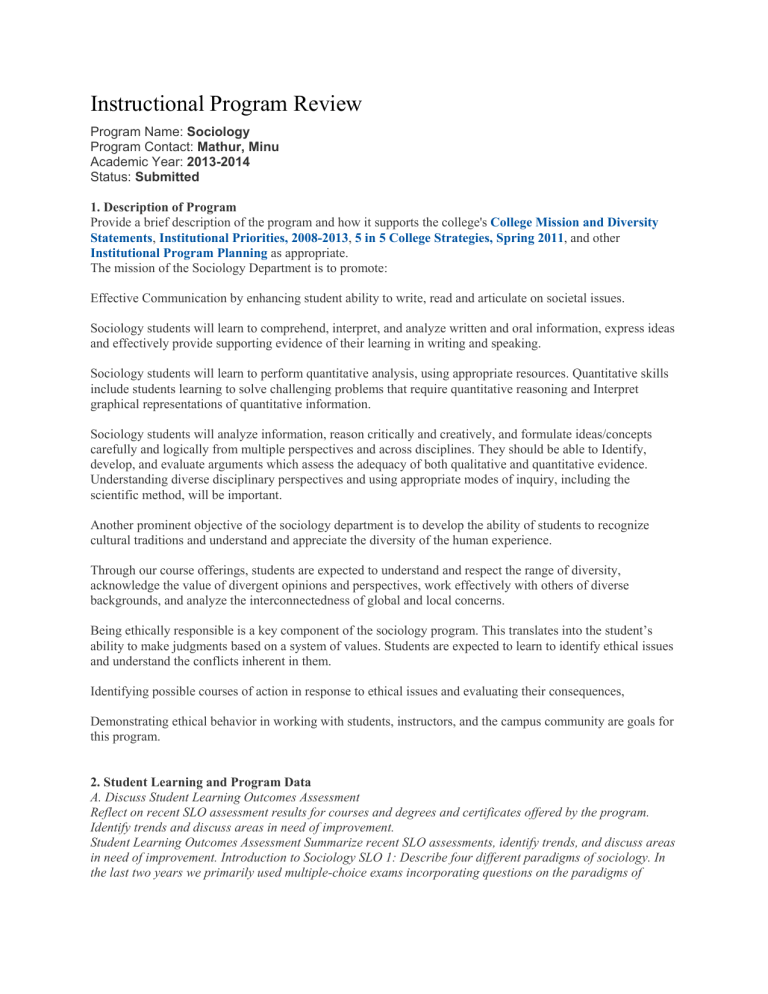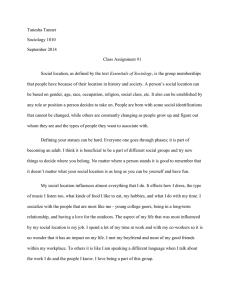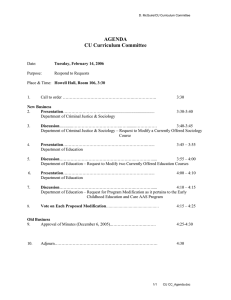Instructional Program Review

Instructional Program Review
Program Name: Sociology
Program Contact: Mathur, Minu
Academic Year: 2013-2014
Status: Submitted
1. Description of Program
Provide a brief description of the program and how it supports the college's College Mission and Diversity
Statements , Institutional Priorities, 2008-2013 , 5 in 5 College Strategies, Spring 2011 , and other
Institutional Program Planning as appropriate.
The mission of the Sociology Department is to promote:
Effective Communication by enhancing student ability to write, read and articulate on societal issues.
Sociology students will learn to comprehend, interpret, and analyze written and oral information, express ideas and effectively provide supporting evidence of their learning in writing and speaking.
Sociology students will learn to perform quantitative analysis, using appropriate resources. Quantitative skills include students learning to solve challenging problems that require quantitative reasoning and Interpret graphical representations of quantitative information.
Sociology students will analyze information, reason critically and creatively, and formulate ideas/concepts carefully and logically from multiple perspectives and across disciplines. They should be able to Identify, develop, and evaluate arguments which assess the adequacy of both qualitative and quantitative evidence.
Understanding diverse disciplinary perspectives and using appropriate modes of inquiry, including the scientific method, will be important.
Another prominent objective of the sociology department is to develop the ability of students to recognize cultural traditions and understand and appreciate the diversity of the human experience.
Through our course offerings, students are expected to understand and respect the range of diversity, acknowledge the value of divergent opinions and perspectives, work effectively with others of diverse backgrounds, and analyze the interconnectedness of global and local concerns.
Being ethically responsible is a key component of the sociology program. This translates into the student’s ability to make judgments based on a system of values. Students are expected to learn to identify ethical issues and understand the conflicts inherent in them.
Identifying possible courses of action in response to ethical issues and evaluating their consequences,
Demonstrating ethical behavior in working with students, instructors, and the campus community are goals for this program.
2. Student Learning and Program Data
A. Discuss Student Learning Outcomes Assessment
Reflect on recent SLO assessment results for courses and degrees and certificates offered by the program.
Identify trends and discuss areas in need of improvement.
Student Learning Outcomes Assessment Summarize recent SLO assessments, identify trends, and discuss areas in need of improvement. Introduction to Sociology SLO 1: Describe four different paradigms of sociology. In the last two years we primarily used multiple-choice exams incorporating questions on the paradigms of
functionalism, conflict theory, symbolic interactionism and post-modernism, administered to the students during test one. 70% of students were able to understand the concepts as discussed in the class.
INSTRUCTION PROGRAM REVIEW: SPRING 2013 SUBMISSION CYCLE Program Review: Sociology
Program Page 2 Form: 11/27/2012 meaning of these four paradigms. Through the services of a sociology tutor provided by the Learning Center, we hope to increase the success rate in the future. Social Problems
SLO1 Define/address social problems using the three major sociological paradigms. SLO2 Focus on social problems involving inequality based on social class, age, race and ethnicity.
SLO3 Discuss the international impact of problems due to population growth, urbanization, poverty, and human development.
SLO4 Discuss problems of the life cycle.
SLO5 Discuss problems arising from the violation of social norms SLO6 Define environmental issues. A pre/post evaluation form was used to elicit information from students about the different SLO’s for the Social
Problems class. Administered in two different sections of Social Problems, the form collected data on the ability of students to understand these concepts. Both sections reported a marginal difference in the response between the pre and post evaluation. Future strategies include more frequent checks on student comprehension of the material.
B. Student Success Indicators
1. Review Student Success and Core Program Indicators and discuss any differences in student success indicators across demographic variables. Also refer to the College Index and other relevant sections of the
Educational Master Plan: Update, 2012 , e.g., Student Outcomes and Student Outcomes: Transfer. Basic Skills programs should also refer to ARCC data.
PR. Sp 2014: Consistent with last year, Asian students show the highest head count. Black, Filipinos, and
Pacific Islanders are showing slightly higher enrollment. Whites from the student population are slightly down. Whites have the highest rate of success, followed by Asians and Filipinos. Interestingly, the last program review indicated Pacific Islanders with the highest rate of success. This year it has come down somewhat.
PR. Sp 2013: Eighty one percent of the students in sociology are age 24 and lower. Success rates for the older student group are somewhat higher. One hundred percent of Sociology classes are UC and CSU transferable.
PR. Sp 2014: The average age of students has gone up slightly to 24.3. Success rates for the older students continue to be somewhat higher. Female enrollment has increased since the last PR cycle while male enrollment has decreased. Females are showing higher rates of increase while males have shown a slight decrease. Withdrawal rates for females is slightly higher while male withdrawal rates remain the same. One hundred percent of Sociology classes are UC and CSU transferable.
PR. Sp 2014: The above mentioned statistics are consistent with division and college totals for head count,
WSCH, retention rates and student success rates.
2. Discuss any differences in student success indicators across modes of delivery (on-campus versus distance education). Refer to Delivery Mode Course Comparison .
PR. Sp 2013: PRIE data indicates a 58.6% success rate for distance education and a 63% for traditional classes at the college level. Similarly the retention rates are 77.4% for distance education and 81.8% for traditional education.
Data for Sociology suggest the opposite trend. While 81.6% of students succeeded in the distance classroom.
Only 58.9% did so in the traditional classroom. Similarly, 95.9% of students were retained in distance education compared to 85.3% in the traditional classroom.
PR. Sp 2014: PRIE indicate success rates are significantly higher in distance education than the traditional classroom for the Creative Arts and Social Science Division and higher than those for the college. While success rates are the highest for the white population, retention is high for both whites and Asians.
C. Program Efficiency Indicators. Do we deliver programs efficiently given our resources?
Summarize trends in program efficiency as indicated in the Student Success and Core Program Indicators
(LOAD, Full-time and Part-time FTEF, etc.)
PR. Sp 2013: Despite a marginal dip in enrollment, WSCH, and FTES, retention has shown a slight improvement and success rates remain steady.
PR. Sp 2014: While WSCH, and FTES numbers have remained the same since the last program review cycle, student retention rates have shown a solid 3% increase.
3. Additional Factors
Discuss additional factors as applicable that impact the program, including changes in student populations, state-wide initiatives, transfer requirements, advisory committee recommendations, legal mandates, workforce development and employment opportunities, community needs. See Institutional Research as needed.
We are not aware of any changes in student populations, state-wide initiatives, transfer requirements, advisory committee recommendations, legal mandates, workforce development and employment opportunities, or community needs effecting changes. However, economic buoyancy in the region may have impacted enrollment.
4. Planning
A. Results of Program Plans and Actions
Describe results, including measurable outcomes, from plans and actions in recent program reviews.
Introduction of online sociology class has been a success. Many students have already transferred with a TMC degree to a prestigious universities. Many sociology students are part of the honors project on campus. Two went on to get their papers published in Think You Journal.
B. Program Vision
What is the program's vision for sustaining and improving student learning and success over the next three years? Make connections to the College Mission and Diversity Statements , Institutional Priorities, 2008-
2013 , and other Institutional Program Planning as appropriate. Address discussion in the Student Learning and Program Data section: SLO assessment results and trends in student success indicators.
[Note: Specific plans to be implemented in the next year should be entered in C of the Planning section.
CTE programs must address changes in the context of completion and employment rates, anticipated labor demand, and any overlap with similar programs in the area as noted in D1 and D2 of the Career Technical
Education section.]
Continue to promote and arrange teaching workshops, guest speakers, etc.
To guide future collaboration across student services, learning support centers, and instructional programs, describe the interactions that would help the program to improve student success.
We believe there is sufficient collaboration across the learning support centers and programs. The Learning support Center staff have made several presentations to our classes in which they outline services available to the students.
1. To guide future faculty and staff development initiatives, describe the professional activities that would be most effective in carrying out the program's vision to improve student learning and success.
Faculty: No major changes are anticipated.
2. To guide future collaboration across student services, learning support centers, and instructional programs, describe the interactions that would help the program to improve student success.
Greater use of services provided by the Learning Center, library, DSPS, Veteran's Center, and Sociology
Tutors.
3. To guide the Institutional Planning Budget Committee (IPBC) in long-range planning, identify any major changes in resource needs anticipated during the next three years. Examples: faculty retirements, equipment obsolescence, space allocation.
See the Resource Requests section below to enter itemized resource requests for next year.
Leave sections blank if no major changes are anticipated.
Faculty
Requesting one full time faculty position.
Equipment and Technology
Instructional Materials
Classified Staff
Facilities
C. Program Plans and Actions to Improve Student Success
Prioritize the plans to be carried out next year to sustain and improve student success. Briefly describe each plan and how it supports the Institutional Priorities, 2008-2013 . For each plan, list actions and measurable outcomes. (Plans may extend beyond a single year.)
Attract more students to the program: Promote sociology TMC degree through at least 4 departments at the college such as ethnic studies, political science, philosophy, and anthropology. Meetings will be set up to discuss requirements and benefits of receiving a
TMC degree in sociology.
Work toward greater retention and success: Introduce at least one group assignment in each class to promote social interaction and achieve a greater personal bond among them.
Greater student engagement in college level activities will be encouraged. Meaningful presentations by external groups (such as Victory over Violence) will also engender student involvement, further enhancing student retention.
Offer more online sociology classes: Introduce an online sociology class that attracts 40 students or more. Statistics indicate a much higher retention rate for our online offerings
5. Resource Requests
Itemized Resource Requests
List the resources needed for ongoing program operation.
Faculty
NOTE: To make a faculty position request, complete Full-time Faculty Position Request Form, AY 2013-
2014 and email to your Dean. This request is separate from the program review.
Full-time faculty requests Number of positions
Full Time Faculty 1
Equipment and Technology
Description
Portable external 24" screen for one laptop computer
One external hard drive for one laptop.
Instructional Material
Description
Sociology Videos
Classified Staff
Cost
$500
Cost
$200
$200
Description Cost
Facilities
For immediate or routine facilities requests, submit a CSM Facility Project Request Form .
Description Cost
6. Program Maintenance
A. Course Outline Updates
Review the course outline update record . List the courses that will be updated in the next academic year. For each course that will be updated, provide a faculty contact and the planned submission month. See the
Committee on Instruction website for course submission instructions . Contact your division's COI representatives if you have questions about submission deadlines.
Career and Technical Education courses must be updated every two years.
Courses to be updated Faculty contact Submission month
B. Website Review
Review the program's website(s) annually and update as needed.
Faculty contact(s)
C. SLO Assessment Contacts
Faculty contact(s)
Date of next review/update
Minu Mathur, Ph.D. Lead faculty. Professor of sociology, College of
San Mateo
Jane Williams, Ph.D. Adjunct professor, College of San Mateo






